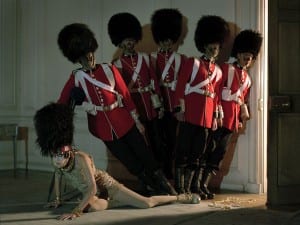Romuald Hazoumé was born 1962 in Porto Novo, a city in the Republic of Benin on the west coast of Africa and currently lives and works there. Though of Yoruba ancestry, Hazoumé was raised in a Catholic family. His work has been exhibited internationally since the late 1980s, yet it is only within the past ten years that Hazoumé has really come to prominence.
Hazoumé’s practice deals with the social and political history of not just Benin, but of Africa and Africa’s dynamic, ever-changing role within the international art scene. He is quick however to repudiate the idea that Africa’s problems exist as an anomaly; “We need to understand that we have the same problems all over the world on different levels. We all take up this “Coca Cola” culture, which makes us unaware of our own culture.” He argues that we exist within a global situation in which we are all unaware of our own direction and origins – a problem that he deals with in his work.
Hazoumé’s La Bouche du Roi, which recently exhibited at the British Museum and will be continuing on a UK tour to Hull, Liverpool, Bristol, and Newcastle, deals with the history of the slave trade in Africa, specifically Benin as a source-point for slave ships during the eighteenth century. Appropriating found objects, in an almost Duchampian way, Hazoumé alters their meaning by placing the concrete object in an unfamiliar role: jerry cans become masks, no longer a vessel to be used to carry fuel, but rather a vessel to signify meaning. These cans, which are pervasive throughout his work are used to consciously call attention to their use in Benin, where the black market for fuel literally fuels an illegal, but prolific trade between Nigeria and the Republic of Benin. An instant correlation can be made between the slave ships of the eighteenth century smuggling people out of Benin and the jerry cans smuggling fuel: the essential problem remains of the exploitation of the resources of Africa. For Hazoumé the idea of Africa as commodity still resonates within contemporary political discourse.
By calling attention to the way in which Africa and its resources are exploited Hazoumé is simultaneously calling attention to the contemporary artists and their position within the contemporary art scene as well. Through specific exhibitions (Africa Remix, Hayward Gallery, 2005), collectors (Jean Pigozzi), and critics (Okwui Enwezor), attention has shifted from western Europe and is now being refocused on contemporary African artists. Hazoumé however resists the categorisation, stereotyping and the very semiotics involved in identifying a “contemporary African art scene” arguing that, “This very thought is a misunderstanding of what contemporary art and art in general mean. But they forget that art essentially is like a potato: it grows everywhere in the world, but it has different tastes.” Artists cannot be categorized according to their place of residence or origin as indicative of their practice and the work that they produce, as this necessarily denigrates their work and the meaning behind it.
Hazoumé, unlike many artists who have homes and studios in various cities, still resides and works in Benin, using the land and the Republic’s history as a source of inspiration for his work: “I answer questions that preoccupy my people. I am compelled to respond in my way.” It is for this reason that the Beninese community is so receptive and cognizant of his work and he continues on to state that, “They know it, because they know me, I am in the midst of them. They do not find out through the local media, because African journalists have ears only for the mediocre politics of our country.”
The lack of media attention within Africa for contemporary art is a major problem, and Hazoumé argues that contemporary African artists only garner media attention within Africa once they have filtered through the foreign press. It is interesting to note that within the past two years, since Africa Remix (2005) and continuing on with the UK celebrations of the abolition of slavery (including amongst other things an exhibition at the Victoria & Albert Museum which Hazoumé participated in), the amount of media attention focused on contemporary African art has increased exponentially. However, the breadth and scope of contemporary art means that no matter how much media and press is focused on Africa we still will be unable to cover it in its entirety. Which is precisely the point really, for as Simon Njami argues in the catalogue produced to accompany Africa Remix at the Hayward, “Then came the masks. But Africa remained silent. Resolutely, fiercely silent. The objects refused to reveal their secrets.” Though critics continue to scrutinise and tear apart contemporary African art, they are often unable to even scratch the surface and are met with continual resistance from the work itself. Hazoumé’s practice functions in the same way: he does not hand you an easy answer or interpretation, but silently argues for the viewer to make their own reading of his work, resisting the increasingly common didactic method of appreciation.
La Bouche du Roi was shown at Merseyside Maritime Museum from 2 August 2007 – 2 September 2007, Bristol’s City Museum & Art Gallery from 15 September 2007 – 28 October 2007, Laing Art Gallery (Newcastle) from 10 November 2007 – 3 February 2008, and the Horniman Museum (London) from 5 December 2008 – 1 March 2009.
Many thanks to The October Gallery for their assistance with the translation from French to English.www.octobergallery.co.uk
Niamh Coghlan





